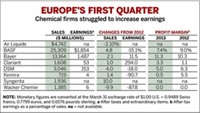Advertisement
Grab your lab coat. Let's get started
Welcome!
Welcome!
Create an account below to get 6 C&EN articles per month, receive newsletters and more - all free.
It seems this is your first time logging in online. Please enter the following information to continue.
As an ACS member you automatically get access to this site. All we need is few more details to create your reading experience.
Not you? Sign in with a different account.
Not you? Sign in with a different account.
ERROR 1
ERROR 1
ERROR 2
ERROR 2
ERROR 2
ERROR 2
ERROR 2
Password and Confirm password must match.
If you have an ACS member number, please enter it here so we can link this account to your membership. (optional)
ERROR 2
ACS values your privacy. By submitting your information, you are gaining access to C&EN and subscribing to our weekly newsletter. We use the information you provide to make your reading experience better, and we will never sell your data to third party members.
Business
European Earnings
The third quarter was generally strong for Europe's chemical companies
by Patricia L. Short
December 4, 2006
| A version of this story appeared in
Volume 84, Issue 49
Akzo Nobel's chief executive officer, Hans Wijers, was speaking for his firm, but he could have been talking about most European chemical companies: "We enjoyed a strong third quarter, building on an excellent first half-year, which demonstrates the company's growth potential. I expect 2006 to be a successful year, with revenue growth and increased operational results at all segments."
Wijers could be particularly pleased with the third quarter, given Akzo's 19% increase in net earnings. The company's Organon health care and coatings divisions led the growth, he said. Organon charted a 25% increase in operating earnings, thanks to revenue growth and improved manufacturing, the company said, and earnings in the coatings division were up 13%, driven by sales growth in all business units.
Two newly hatched companies were among the European strongest performers in the quarter.
For Lanxess, spun off from Bayer in January 2005, sales were down slightly in the quarter following divestments of its fibers and paper chemicals businesses and the iSL-Chemie unit of subsidiary Rhein Chemie. Without those divestments and negative currency effects relating to the U.S. dollar, the company said, sales would have risen by 2%.
Third-quarter net earnings at Lanxess were $45.7 million, a pleasing change from the loss of $72.0 million in third-quarter 2005. Operating earnings, before exceptional items, rose by 16% to $129 million. Lanxess attributed the earnings strength in part to its ability to offset higher feedstock and energy costs with price increases.
At Arkema, the former Total subsidiary that was launched on the stock market in May, third-quarter 2006 brought increases in sales and net income compared with the same quarter in 2005. What the company termed a strong increase in average selling prices throughout its three business segments more than offset a decrease in sales volumes—a result of restructuring—and negative currency effects.
The Belgian conglomerate Solvay attributed its good third quarter to operating earnings increases of 26% in its plastics division and 20% in its chemical division. Operating earnings in the company's pharmaceutical division were up by 3%, although sales were down by 4%, primarily because of the expiration of marketing rights for a key gastroenterology drug.
BASF's net earnings fell by 24% because of special items. The company did not report net earnings excluding these items, but it did point out that operating income before special items rose by 22% to $2.05 billion. Only BASF's agriculture and nutrition division posted an operating loss, $69 million, in the quarter.
BASF's sales in the quarter grew 28%, 18% of which reflected the acquisitions of Engelhard, Degussa's construction chemicals business, and Johnson Polymer. Higher sales prices in the company's chemical businesses and in the oil and gas operations added another 9% to growth, and increased volumes, another 3%; adverse currency effects, however, shaved 2% from the total.
Although BASF was able to pass raw material price increases through in its own selling prices, its compatriot firm Bayer showed a more mixed impact. Its sales were up modestly: 3% in the quarter for continuing operations, excluding recently acquired Schering; including Schering's operations in its third-quarter accounts, however, bumped up sales by 26%. And Bayer's net income, excluding nonrecurring items but including Schering, was up by 33% in the quarter.
Bayer Chairman Werner Wenning noted that the overall improvement "was very largely attributable to HealthCare," with earnings of MaterialScience and CropScience declining from the year-earlier period. He said the operating results of MaterialScience declined by 15% in the quarter, "mainly due to the substantial rise in petrochemical feedstock costs, which was only partly offset by volume increases."
The company's CropScience group showed a drop in operating profits of 18% in the quarter. Sales were hard-hit by adverse weather conditions in North America, Latin America, Australia, and parts of Europe; by the growing presence of generics; and by the increasing acceptance of genetically modified products, which need fewer agrochemicals.
According to Merck Chairman Michael Roemer, third-quarter results "were quite acceptable," given that the year-ago period contained $89 million in one-time payments. The adverse comparison caused a drop in operating earnings of close to 10% compared with the same period in 2005.
Merck's sales were up 5%, paced by a 7% increase in pharmaceutical sales in the quarter. The company's star earner was the cancer treatment Erbitux, which enjoyed a 46% sales increase in the quarter. Sales in the company's liquid-crystal division, meanwhile, increased by 4%.
For Clariant, continuing operations rang up a net loss of $11.2 million in the third quarter, compared with a profit of about $88 million in third-quarter 2005. Discontinued operations, primarily the company's custom manufacturing business, yielded a further loss for the 2006 quarter of $62 million.
"We have seen a positive trend in pricing negotiations," said Clariant CEO Jan Secher, "enabling us to raise our prices by over half a percentage point in the third quarter." The improvement, the company said, contributed to an operating profit of $182 million before nonrecurring items. Gross sales margins increased compared with the 2005 quarter despite the continued rise in raw material and energy costs.
Clariant noted, however, that performance in its life sciences chemicals division "continued to deteriorate significantly." Custom manufacturing performance declined because of depressed agrochemical markets. And Clariant's specialty intermediates business suffered from notably weaker demand—and subsequent lower operating profits—than in the same quarter in 2005.
Rhodia, one of last year's problem companies, showed a net profit for the third quarter, continuing its positive performance for 2006. Rhodia's continuing operations posted a net profit of nearly $93 million in the quarter, compared with a net loss of $107 million a year earlier.
The third quarter was marked, the company said, by the "very significant" impact of price increases and strong growth in sales volumes driven by robust demand across all businesses.
In general, nearly all European chemical companies expect 2006 to wrap up as a good year, albeit one marked by challenges. As Rhodia put it, "Market conditions should remain satisfactory in the fourth quarter in an environment still shaped by high volatile raw material and energy prices."
Read More
- European Company Earnings
- Sales growth is modest in the third quarter, but earnings increases are mainly strong





Join the conversation
Contact the reporter
Submit a Letter to the Editor for publication
Engage with us on Twitter